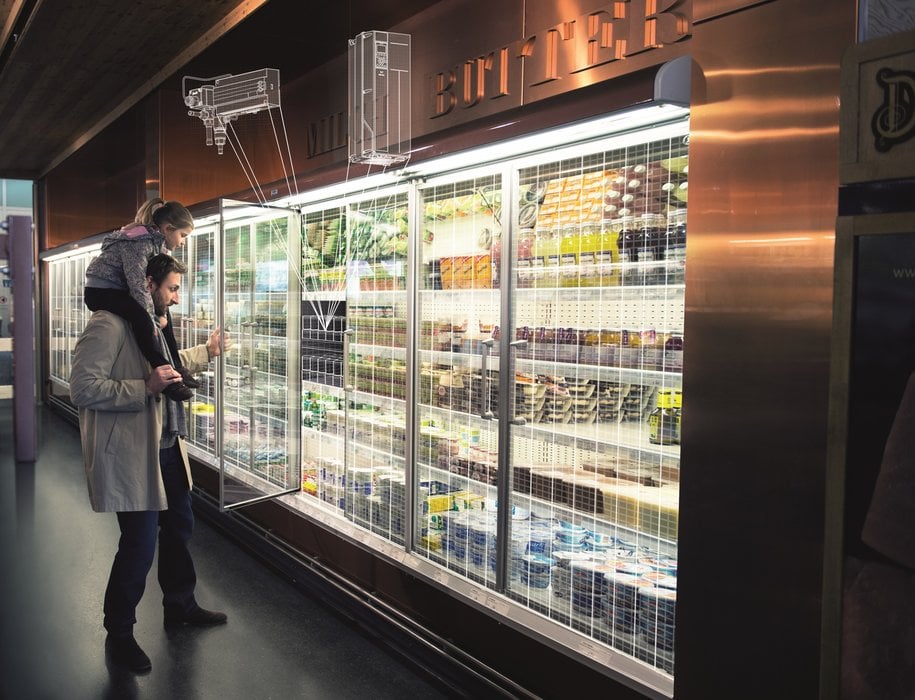Supermarkets for Flexibility and Storage in Energy Systems

Background
Supermarkets provide excellent opportunities to help solve the need for energy demand- response in the next generation of our energy system. Since supermarkets are found in all local settings, rural and urban, they can provide local energy solutions for low-carbon city development in energy efficient ways.
1. Flexibility: The potential of adding the flexibility of supermarkets to the smart grid demands equals 17.5% of the wind electricity in Germany or up to 30 % of the wind electricity in the EU.
2. Storage: Adding the potential of today’s unused compressor capacity could add another 100% to the demand response flexibility in the event of overproduction of wind electricity. In connection with external thermal networks such as district heating, supermarkets may serve as storage opportunity for renewable energy sources, like wind.
The business case for connecting supermarkets with electricity and heating networks stems from energy and CO2 savings and very short payback times for the supermarket owner.
Concept: Super Markets and District Energy
The cooling process in supermarkets produces heat and traditionally the heat goes unused being wasted into the atmosphere. Surplus industry heat of cooling processes can be recovered as a heating source for the store itself or as heat source for the local district heating network. This combined cooling and heating process is increasingly getting deployed in supermarkets as a sustainable and attractive business case. It contributes first to energy reduction targets of local utilities, as well as to CO2 reduction targets, while providing a new source of income to the store owner.
Supermarkets as Virtual Power Plants and Integration of Renewables
Supermarkets are designed for a very high cooling load to stand extreme summer conditions with high temperatures and high humidity. As a result the compressors run on average with only 30% of their full capacity. By connecting the supermarket to a district energy network, this potential can be leveraged to add extra capacity to the network in order to balance peak loads.
Local district energy networks are very effective to balance fluctuating supply from renewable energy, like wind and sun to meet the demand of electricity during peak load. They act as storage facility to provide the required demand response. Supermarkets as ‘virtual power plants’ utilize the flexibility in the cooling demand and for other electricity consuming activities like defrosting.
Environmental and Economic Benefits
Heat loss is minimized as the heat is generated close to the consumers. The heat loss from the refrigeration system to the environment is reduced considerably (40%) and turned into revenue streams for the supermarket.
Business Case: Even with a conservative heat value rate (25€ per MWh) the payback time for the investment is only 1½ years.
Case Story
20 Danish supermarkets send their surplus heat into the local district heating networks – in the case of a local supermarket close to the Danfoss headquarter more than EUR 27,000 are saved annually on gas. CO2 emissions are reduced by 34% by utilizing the surplus heat from the refrigeration system for domestic hot water, among other things. With a new district heating connection, the local supermarket has one more source of income, by selling heat to the Sønderborg District Heating consumers.
Conclusion
- Supermarkets can play an important role in the coming smart grid market. The offered flexibility is attractive and can relatively easy become operational without major investments. The flexibility has shown to be operational from the very fast response times to longer scheduled events.
- The main barrier for a wider introduction is the missing business models and market regulations on the electricity grid side.
- Supermarkets can become important heat contributors for the district heating grid. The obvious advantages as fast payback and reduced emissions make the heat export case very attractive for all stakeholders.
- If the full potential of installed compressor capacity could be utilised for creating heat during low electricity price time slots, a considerable contribution to the overall heating can be obtained.
References
[1] Arnemann M. Real Energy Efficiency in Supermarket Refrigeration systems, Institute of Refrigeration Karlsruhe University of Applied Sciences, 2014.
[2] Lund,H et al ; 4th Generation District Heating (4GDH) Integrating smart thermal grids into future sustainable energy systems; Energy (2014), http://dx.doi.org/10.1016/j.energy.2014.02.089
[3] Funder-Kristensen T. Fösel G. Bjerg P. ; Supermarket refrigeration and heat recovery using CO2 as refrigerant, Cryogenics and Refrigeration Proceedings of ICCR2013 Paper ID: B129
[4] EU energy in figures , Statistical pocket book 2014, ISBN 978-92-79-29317-7
[5] Funder-Kristensen T., Green T., and Bjerg P. (2015) Supermarket refrigeration as an important smart grid appliance.
Refer
Reference

